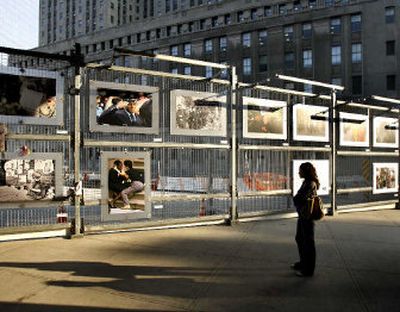Not a matter of if, but when, experts say

WASHINGTON – The threat of terrorism against the United States remains chillingly lethal five years after 9/11, and offi-cials predict that another massive attack is not a matter of if, but when.
Despite a government overhaul and more than $250 billion spent to bolster security on airlines, at borders and in seaports, few doubt al-Qaida’s intent to strike the United States again. That the nation hasn’t been hit since Sept. 11, 2001, may say as much about terrorists’ patience as it does about steps taken to stop them.
“I know of nobody in the intelligence field who doesn’t believe there will be another attack,” said Thomas Kean, former New Jersey governor and Republican chair of the 9/11 Commission that investigated the government’s security missteps leading up to the 2001 hijackings.
“There’s going to be another attack,” Kean said. “They just can’t tell you when.”
In a new age of rapid and widespread ID checks, locked and bulletproof cockpit doors in airliners, armed pilots, tracking of foreigners’ visas and monitoring of Muslim and Arab communities, few expect a precise repeat of the plot that used airline hijackings to bring down huge buildings.
The unsettling reality of terrorism, however, is that it is always in search of new ways to accomplish mass death and destruction – and always in search of the weakest link.
Authorities have disrupted a number of high-profile plots, including last month’s bombing scare on as many as 10 Britain-to-U.S. flights. The CIA has helped ensnare some 5,000 terror suspects around the world. And the U.S. government has imposed hundreds of security measures on foreign visitors and U.S. residents alike, from making travelers take off their shoes at airport checkpoints to eavesdropping on phone and e-mail conversations.
But glaring gaps in the security net remain.
Undercover inspectors testing the nation’s security system have repeatedly sneaked weapons through airport checkpoints, entered the country with fake identification and foiled detectors that catch the trace amounts of radiation in kitty litter and bananas, but not always nuclear materials. Air testers to sniff out biological agents are becoming obsolete. And not all port or airline cargo is rigorously inspected.
And, as Hurricane Katrina showed last year, disaster response systems at all levels of government are woefully unprepared for a catastrophe.
“No matter what you do, it’s not enough,” said Rep. Carolyn Maloney, D-N.Y., co-chair of a congressional Sept. 11 caucus. “But the systems we’ve worked hard on to put in place are not working.”
Homeland Security Secretary Michael Chertoff, whose department was created in 2003 as a result of Sept. 11, points to strides made in sharing intelligence and screening passengers and cargo on flights and at seaports as proof that the country has been made safer without shutting down commerce. Yet he acknowledges more needs to be done in his agency, which largely grapples with reacting to past crises while also thinking about what terrorists might try next.
The intelligence community spends a significant amount of time doing what Chertoff described as “putting ourselves in the heads of terrorists – looking at emerging techniques and trying to figure out how terrorists might exploit our systems.”
In one example, Chertoff said, the department last year relaxed its ban on scissors and small innocuous tools from being carried on planes to give inspectors more time to look for explosive devices. Screeners also are now being trained to interpret facial expressions and other behavioral patterns to pick out suspicious travelers.
“We will live with some form of this problem for a very long time,” Chertoff said in an hour-long interview last month wedged between a phone call with British Home Secretary John Reid about the foiled flight plot and a meeting with FEMA director David Paulison about the hurricane season.
Several government-appointed panels – including the 9/11 Commission – have concluded over the last five years that the nation was vastly unprepared for the deadly attacks.
Their findings triggered a massive re- shuffling of the government’s counterterror missions, the largest since the Defense Department was created in 1947. In addition to merging 22 agencies into the new Homeland Security Department, a new position of intelligence director to oversee the nation’s 16 spy agencies was established.
Congress approved policies such as the USA Patriot Act, allowing more surveillance in counterterrorism investigations. Federal spending on domestic security programs has more than tripled since 2001, to $55 billion this year, almost equal to what is spent on education.
The results have been mixed. Criticism for Homeland Security has run from sweeping (for cutting emergency responder funding to New York and Washington) to nitpicking (the color-coded threat alert system is too vague to be meaningful).
“Everything the department was supposed to do is still, at best, a work in progress,” said Clark Kent Evin, Homeland Security’s former inspector general.
Meanwhile, the government’s once-greatest target in the war on terror – Osama bin Laden – remains on the loose. Michael Scheuer, the former head of the now-defunct CIA unit dedicating to finding the al-Qaida leader, said catching him now is mostly a matter of luck. “He’s going to have to zig when we zag and we’ll end up in the same place at once,” Scheuer said.
With or without bin Laden, authorities expect al-Qaida’s threat won’t dim in coming years.
Some sympathizers – including small pockets of homegrown Islamic extremists already in the United States – may not even be directly linked to al-Qaida but aim to carry out its mission. Those who make up al-Qaida’s core will wait years, and even decades, for the chance to attack when America least expects it.
“I’m convinced they’re prepared to wait centuries if they have to,” former Homeland Security Secretary Tom Ridge said. “They’re looking much longer term than we are. So we have to match their patience with our persistence and our continued focus. We can never let our guard down.”